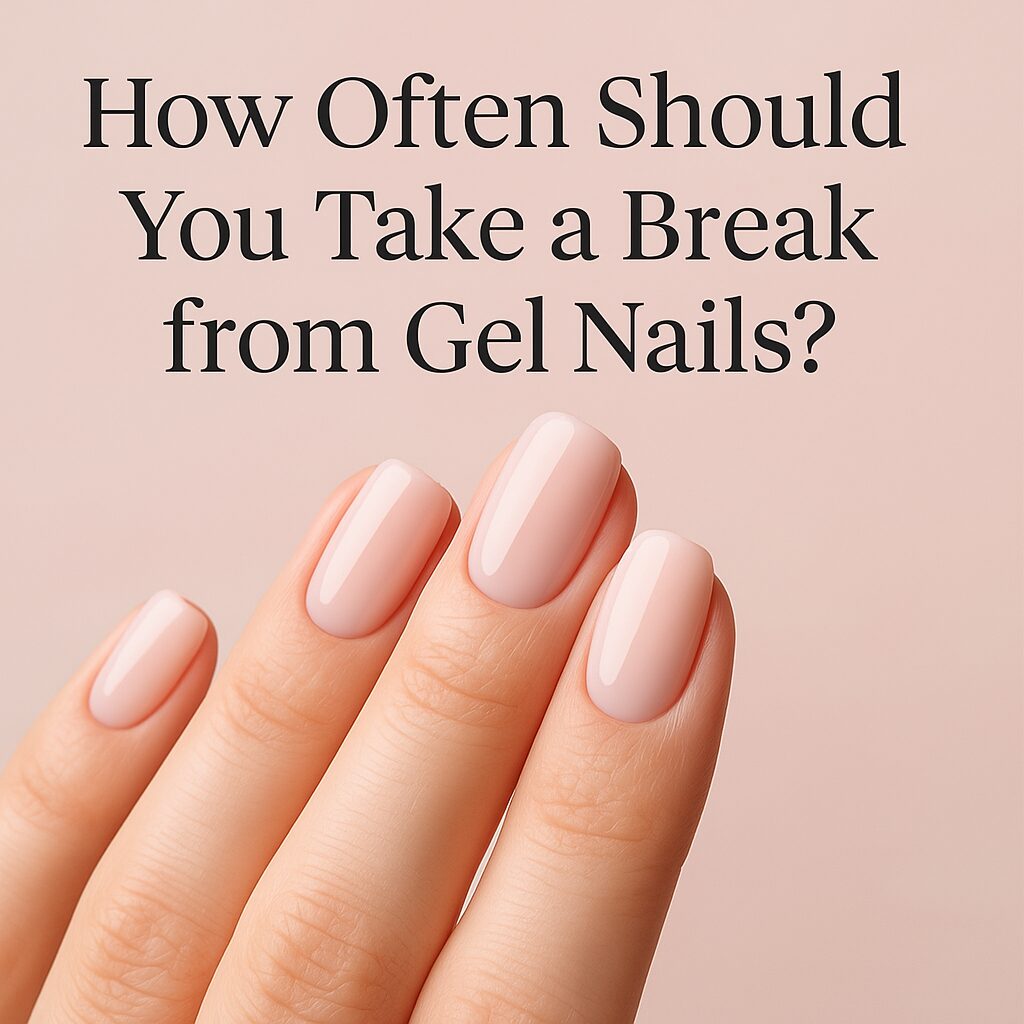
There’s nothing quite like that just-cured gel manicure — glossy, chip-free, and effortlessly perfect for weeks. But if you’ve been wearing gels back-to-back without a break, you might notice your nails feeling thinner, drier, or more fragile than before.
The truth is, even though gel nails are incredibly durable, your natural nails underneath still need time to rest and recover. Knowing how often to take a break from gel nails can make the difference between strong, healthy nail beds and peeling, brittle nails.
Let’s break down what the experts recommend, how to spot when your nails need a timeout, and the best ways to restore your natural nail strength in between manicures.
Why Gel Nails Can Be Tough on Natural Nails
Gel polish itself isn’t harmful — in fact, modern formulas are quite advanced. The issue lies in what happens before and after application.
To prep nails, technicians usually buff the nail surface to help the gel adhere better. Over time, that repeated filing can thin your nail plate. Then comes removal — soaking in acetone and scraping off layers of cured gel, which can strip away natural oils and dehydrate nails.
If you repeat that cycle without rest, your nails don’t have a chance to rehydrate or rebuild their natural strength.
Common side effects of continuous gel manicures:
- Peeling or flaking nails
- Brittleness and dryness
- White patches or uneven texture
- Soreness or sensitivity after removal
Quick Tip: It’s not the gel that harms your nails — it’s skipping the recovery phase. Your nails need a breather to re-hydrate and strengthen before the next set.
So, How Often Should You Take a Break from Gel Nails?
Most professional nail techs recommend taking a 1–2 week break after every 2–3 gel manicures.
That means if you get a fresh gel set every two to three weeks, plan a short break after your second or third appointment — around every 8–10 weeks of wear.
Here’s a simple rule:
- If your nails feel strong and flexible: You can wear gels for 3 months, then rest for 1–2 weeks.
- If your nails feel dry, weak, or peeling: Take a longer break — around 3–4 weeks — to allow full recovery.
These short breaks allow your nails to:
- Rebalance natural moisture levels.
- Recover from acetone exposure.
- Rebuild keratin layers for strength and flexibility.
Pro Tip: Plan your “gel breaks” between seasons or after major events (like weddings or vacations) — it’s the perfect time to let your nails breathe while still looking neat.
Signs It’s Time to Take a Manicure Break
If your nails could talk, they’d tell you exactly when they need rest. Look out for these telltale signs:
- Peeling or flaking layers — your nails look uneven or paper-thin.
- White, chalky spots — a sign of dehydration from acetone.
- Softness or bending — your nails no longer feel firm.
- Splitting or breaking easily — weakened structure.
- Tenderness or soreness — your nail beds feel sensitive after removal.
If you notice two or more of these, it’s your signal to press pause on gels.
Expert Advice: Don’t cover up damage with another gel set — you’ll only make it worse. Instead, shift your focus to hydration and recovery.
What to Do During Your Gel Nail Break
Your “gel detox” doesn’t have to feel boring — it’s a chance to pamper and repair your nails naturally.
Here’s how to make the most of your time off:
1. Rehydrate Daily
Gel manicures and acetone removal deplete your nails of moisture.
Replenish it by:
- Applying cuticle oil 2–3 times daily (jojoba, vitamin E, or almond oil are great choices).
- Using a rich hand cream after every wash.
- Sleeping with a moisturizing hand mask once a week.
Tip: Massage oil into your nail beds — it boosts circulation and encourages healthy nail growth.
2. Use a Strengthening Treatment
A high-quality nail strengthener is your best friend during breaks.
Look for ingredients like keratin, calcium, or biotin, which help reinforce the nail plate.
Apply it every 2–3 days for continuous protection.
3. Keep Nails Short and Smooth
Trim away weak ends and file with a fine-grit glass or crystal file to avoid tearing.
Shorter nails experience less stress and recover faster.
Pro Tip: Avoid metal files — they can cause micro-cracks in soft nails.
4. Avoid Harsh Chemicals
Household cleaners, sanitizers, and soaps can dry your nails further.
- Always wear gloves when cleaning or washing dishes.
- Avoid soaking your hands in water for long periods.
If you want to paint your nails during your break, use breathable polish or a treatment base coat instead of gel.
5. Give Nails a True “No Polish” Day
It’s okay to go bare for a few days. Nails don’t technically “breathe” — they’re made of keratin — but removing all coatings helps them rehydrate naturally through the nail bed and surrounding skin.
Think of it as your “nail spa reset.”
How to Protect Your Nails Between Gel Manicures
Taking breaks is just one part of the equation — the real magic is in how you care for your nails between gel sets.
Here’s how to keep your nails healthy year-round:
- Never peel off gel polish. It removes nail layers with it.
- Opt for soak-off removal instead of aggressive filing.
- Apply cuticle oil daily — even when gels are on.
- Don’t skip base coats. They prevent staining and strengthen adhesion.
- Limit constant back-to-back gel sets. Add recovery cycles into your manicure plan.
Analogy Tip: Think of your nails like hair — if you color or style them too often without conditioning, they become weak. Gel breaks are like deep-conditioning days for your nails.
How to Recover Damaged Nails After Gel Polish
If you’ve worn gels continuously for months and your nails feel thin, don’t panic — recovery is completely possible.
Your 4-step nail recovery plan:
- Cut and file gently. Shorten damaged edges to prevent further splitting.
- Rehydrate constantly. Use cuticle oil morning and night.
- Apply nail repair treatments. Choose products with strengthening proteins and nutrients.
- Be patient. It takes 3–6 months for a full nail to regrow completely.
Bonus Tip: During this time, use a sheer pink or nude polish with fortifying ingredients. It protects your nails while keeping them looking clean and polished.
Are There Gentler Alternatives to Regular Gel?
If you’re not ready to give up the gel shine, try these nail-friendly alternatives:
- Builder Gel (BIAB): A flexible strengthening overlay that supports natural growth.
- Soft Gel Extensions: Lightweight and soak-off friendly.
- Rubber Base Gel: Adds strength with less filing.
- Hybrid Polishes: Long-lasting but easier to remove than traditional gels.
Myths About “Letting Nails Breathe”
Let’s clear up one of the most common misconceptions:
Nails don’t “breathe.” They don’t have pores or lungs.
What they do need is a break from constant chemical exposure so that moisture and oils from your skin can re-balance naturally.
So instead of calling it a “breathing break,” think of it as a hydration and recovery phase.
Expert-Recommended Gel Nail Routine
Here’s a simple, sustainable schedule that keeps your nails healthy long-term:
| Time Period | Recommended Routine |
|---|---|
| Weeks 1–4 | Gel manicure |
| Weeks 5–8 | Gel manicure |
| Weeks 9–10 | Take a 2-week gel break with nail oil + treatment |
| Weeks 11–12 | Apply new gel set on healthy base |
This cycle lets your nails rest while maintaining consistent style.
More nail care tips : How to Make Nail Polish Last Long
FAQs
Q1: Is it bad to keep getting gel nails back-to-back?
A: Not always, but prolonged, unbroken wear can dry and weaken nails. Small breaks keep them strong.
Q2: How long should I let my nails rest between gel sets?
A: 1–2 weeks after every 2–3 manicures is ideal.
Q3: Can gel nails permanently damage your nails?
A: No. Damage comes from improper removal or lack of care, not the gel itself.
Q4: How can I strengthen my nails during a break?
A: Use cuticle oil daily, apply strengthening base coats, and avoid acetone.
Q5: Can I wear regular polish while taking a gel break?
A: Yes! Just opt for breathable or treatment formulas and skip harsh removers.
